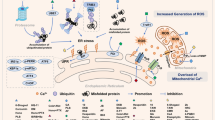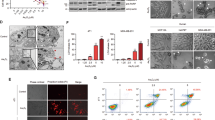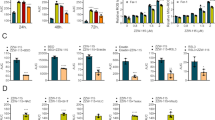Abstract
The tumor necrosis factor-related apoptosis-inducing ligand (TRAIL, Apo-2L) is a recently characterized member of the family of programmed cell death-inducing ligands that includes TNF-α and CD95L (FasL). It is well known that TRAIL binds to the death signaling receptors, DR4 and DR5, and initiates the TRAIL death pathway. Activation of this pathway, mediated through a caspase cascade, causes apoptosis. In this study, we hypothesized that oxidative stress facilitates TRAIL-induced apoptosis by promoting caspase activity through cytochrome c release from mitochondria. Human colorectal carcinoma CX-1 cells were treated with various concentrations of TRAIL (12.5–200 ng/ml) and/or sodium nitroprusside (SNP; 0.03–1 mM) for 12 h. SNP, a nitric oxide donor, which had little toxic effect by itself, enhanced TRAIL-induced cytotoxicity. For example, TRAIL-induced apoptosis (200 ng/ml) was increased by a factor of 2.5-fold in the presence of 1 mM SNP. The combined treatment also caused an increase in cytochrome c release, caspase-3 activity, and PARP cleavage. Overexpression of Bcl-2 completely blocked the SNP-promoting effects, but only moderately inhibited TRAIL-induced apoptosis. Similar results were observed in the presence of hydrogen peroxide or peroxynitrite. Taken together, the present studies suggest that SNP enhances TRAIL-induced cytotoxicity by facilitating the mitochondria-mediated caspase signal transduction pathway.
This is a preview of subscription content, access via your institution
Access options
Subscribe to this journal
Receive 50 print issues and online access
$259.00 per year
only $5.18 per issue
Buy this article
- Purchase on Springer Link
- Instant access to full article PDF
Prices may be subject to local taxes which are calculated during checkout










Similar content being viewed by others
Abbreviations
- TRAIL:
-
tumor necrosis factor-related apoptosis-inducing ligand
- SNP:
-
sodium nitroprusside
- TNF-α:
-
tumor necrosis factor α
- PARP:
-
poly(ADP-ribose) polymerase
- DTT:
-
dithiothreitol
- HEPES:
-
N-[2-hydroxyethyl]piperazine-N′-[2-ethanesulfonic acid]
- PAGE:
-
polyacrylamide gel electrophoresis
- SDS:
-
sodium dodecyl sulfate
- FasL:
-
Fas ligand
- FADD:
-
Fas-associated death domain
- NO:
-
nitric oxide
- PVDF:
-
polyvinylidine difluoride
- ECL:
-
enhanced chemiluminescence
- EDTA:
-
ethylenediaminetetraacetic acid
- EGTA:
-
Ethylenebisoxyethylenenitrilotetraacetic acid
- PMSF:
-
phenylmethylsulfonyl fluoride
- KCN:
-
potassium ferricyanide
- FLIP:
-
Fas-associated death domain-like interleukin-1β-converting enzyme-inhibitory protein
- FAP-1:
-
Fas-associated phosphatase-1.
References
Albina JE, Cui S, Mateo RB, Reichner JS . 1993 J. Immunol. 150: 5080–5085
Ashkenazi A, Pai RC, Fong S, Leung S, Lawrence DA, Marsters SA, Blackie C, Chang L, McMurtrey AE, Hebert A, DeForge L, Koumenis IL, Lewis D, Harris L, Bussiere J, Koeppen H, Shahrokh Z, Schwall RH . 1999 J. Clin. Investig. 104: 155–162
Ashkenazi A, Dixit VM . 1999 Curr. Opin. Cell Biol. 11: 255–260
Bal-Price A, Borutaite V, Brown GC . 1999 Ann. NY Acad. Sci. 893: 376–378
Blanco FJ, Ochs RL, Schwarz H, Lotz M . 1995 Am. J. Pathol. 146: 75–85
Brockhaus F, Brune B . 1999 Oncogene 18: 6403–6410
Brookes PS, Salinas EP, Darley-Usmar K, Eiserich JP, Freeman BA, Darley-Usmar VM, Anderson PG . 2000 J. Biol. Chem. 275: 20474–20479
Ceneviva GD, Tzeng E, Hoyt DG, Yee E, Gallagher A, Engelhardt JF, Kim YM, Billiar TR, Watkins SA, Pitt BR . 1998 Am. J. Physiol. 275: L717–L728
Chinnaiyan AM, Prasad U, Shankar S, Hamstra D, Shanaiah M, Chenevert TL, Ross BD, Rehemtulla A . 2000 Proc. Natl. Acad. Sci. USA 97: 1754–1759
Chlichlia K, Peter ME, Rocha M, Scaffidi C, Bucur M, Krammer PH, Schirrmacher V, Umansky V . 1998 Blood 91: 4311–4320
Degli-Esposti MA, Smolak PJ, Walczak H, Waugh J, Huang CP, DuBose RF, Goodwin RG, Smith CA . 1997a J. Exp. Med. 186: 1165–1170
Degli-Esposti MA, Dougall WC, Smolak PJ, Waugh JY, Smith CA, Goodwin RG . 1997b Immunity 7: 813–820
Fehsel K, Kroncke KD, Meyer KL, Huber H, Wahn V, Kolb-Bachofen V . 1995 J. Immunol. 155: 2858–2865
Gazitt Y, Shaughnessy P, Montgomery W . 1999 Cytokine 11: 1010–1019
Geller DA, Billiar TR . 1998 Cancer Metastasis Rev. 17: 7–23
Ghafourifar P, Schenk U, Klein SD, Richter C . 1999a J. Biol. Chem. 274: 31185–31188
Ghafourifar P, Klein SD, Schucht O, Schenk U, Pruschy M, Rocha S, Richter C . 1999b J. Biol. Chem. 274: 6080–6084
Griffith TS, Chin WA, Jackson GC, Lynch DH, Kubin MZ . 1998 J. Immunol. 161: 2833–2840
Gura T . 1997 Science 277: 768
Ho YS, Wang YJ, Lin JK . 1996 Mol. Carcinog. 16: 20–31
Hortelano S, Dallaporta B, Zamzami N, Hirsch T, Susin SA, Marzo I, Bosca L, Kroemer G . 1997 FEBS Lett. 410: 373–377
Irmier M, Thome M, Hahne M, Schneider P, Hofmann K, Steiner V, Bodmer JL, Schroter M, Burns K, Mattmann C, Rimoldi D, French LE, Tschopp J . 1997 Nature 388: 190–195
Itoh N, Tsujimoto Y, Nagata S . 1993 J. Immunol. 151: 621–627
Jo M, Kim TH, Seol DW, Esplen JE, Dorko K, Billiar TR, Strom SC . 2000 Nature Med. 6: 564–567
Keane MM, Ettenberg SA, Nau MM, Russell EK, Lipkowitz S . 1999 Cancer Res. 59: 734–741
Kim YM, Chung HT, Simmons RL, Billiar TR . 2000 J. Biol. Chem. 275: 10954–10961
Kischkel FC, Lawrence DA, Chuntharapai A, Schow P, Kim KJ, Ashkenazi A . 2000 Immunity 12: 611–620
Kuang AA, Diehl G, Zhang J, Winoto A . 2000 J. Biol. Chem. 275: 25065–25068
Kumar D, Whiteside TL, Kasid U . 2000 J. Biol. Chem. 275: 2973–2978
Li J, Bombeck CA, Yang S, Kim YM, Billiar TR . 1999 J. Biol. Chem. 274: 17325–17333
Lin KT, Xue JY, Nomen M, Spur B, Wong PY . 1995 J. Biol. Chem. 270: 16487–16490
Marsters SA, Sheridan JP, Pitti RM, Huang A, Skubatch M, Baldwin D, Yuan J, Gurney A, Goddard AD, Godowski P, Ashkenazi A . 1997 Curr. Biol. 7: 1003–1006
Messmer UK, Lapetina EG, Brune B . 1995 Mol. Pharmacol. 47: 757–765
Nagane M, Pan G, Weddle JJ, Dixit VM, Cavenee WK, Huang H-JS . 2000 Cancer Res. 60: 847–853
Pan G, O'Rourke K, Chinnaiyan AM, Gentz R, Ebner R, Ni J, Dixit VM . 1997a Science 276: 111–113
Pan G, Ni J, Wei YF, Yu G, Gentz R, Dixit VM . 1997b Science 277: 815–818
Pitti RM, Marsters SA, Ruppert S, Donahue CJ, Moore A, Ashkenazi A . 1996 J. Biol. Chem. 271: 12687–12690
Saleh A, Srinivasula SM, Acharya S, Fishel R, Alnemri ES . 1999 J. Biol. Chem. 274: 17941–17945
Scaffidi C, Fulda S, Srinivasan A, Friesen C, Li F, Tomaselli KJ, Debatin K-M, Krammer PH, Peter ME . 1998 EMBO J. 17: 1675–1687
Sheikh MS, Burns TF, Huang Y, Wu GS, Amundson S, Brooks KS, Fornace Jr AJ, El-Deiry WS . 1998 Cancer Res. 58: 1593–1598
Sheridan JP, Marsters SA, Pitti RM, Gurney A, Skubatch M, Baldwin D, Ramakrishnan L, Gray CL, Baker K, Wood WI, Goddard AD, Godowski P, Ashkenazi A . 1997 Science 277: 818–821
Slee EA, Harte MT, Kluck RM, Wolf BB, Casiano CA, Newmeyer DD, Wang HG, Reed JC, Nicholson DW, Alnemri ES, Green DR, Martin SJ . 1999 J. Cell Biol. 144: 281–292
Sprick MR, Weigand MA, Rieser E, Rauch CT, Juo P, Blenis J, Krammer PH, Walczak H . 2000 Immunity 12: 599–609
Stamler JS, Singel DJ, Loscalzo J . 1992 Science 258: 1898–1902
Tamatani M, Ogawa S, Niitsu Y, Tohyama M . 1998 J. Neurochem. 71: 1588–1596
Thome M, Schneider P, Hofmann K, Fickenscher H, Meinl E, Neipel F, Mattman C, Burns K, Bodmer JL, Schroter M, Scaffidi C, Klammer PM, Peter ME, Tschopp J . 1997 Nature 386: 517–521
Ushmorov A, Ratter F, Lehmann V, Droge W, Schirrmacher V, Umansky V . 1999 Blood 93: 2342–2352
Walczak H, Degli-Esposti MA, Johnson RS, Smolak PJ, Waugh JY, Boiani N, Timour MS, Gerhart MJ, Schooley KA, Smith CA, Goodwin RG, Rauch CT . 1997 EMBO J. 16: 5386–5397
Walczak H, Miller RE, Ariail K, Gliniak B, Griffith TS, Kubin M, Chin W, Jones J, Woodward A, Le T, Smith C, Smolak P, Goodwin RG, Rauch CT, Schuh JC, Lynch DH . 1999 Nature Med. 5: 157–163
Weller M, Malipiero U, Aguzzi A, Reed JC, Fontana A . 1995 J. Clin. Invest. 95: 2633–2643
Wiley SR, Schooley K, Smolak PJ, Din WS, Huang CP, Nicholl JK, Sutherland GR, Davis Smith T, Rauch C, Smith CA, Goodwin RG . 1995 Immunity 3: 673–682
Zhou YW, Komada Y, Inaba H, Azuma E, Sakurai M . 1998 Cell Immunol. 186: 103–110
Zou H, Li Y, Liu X, Wang X . 1999 J. Biol. Chem. 274: 11549–11556
Acknowledgements
This research was supported by NCl Grants CA48000, CA-64139, NIH GM44100 and DOD DAMD17-99-1-9442 grants.
Author information
Authors and Affiliations
Rights and permissions
About this article
Cite this article
Lee, Y., Lee, K., Kim, HR. et al. Sodium nitroprusside enhances TRAIL-induced apoptosis via a mitochondria-dependent pathway in human colorectal carcinoma CX-1 cells. Oncogene 20, 1476–1485 (2001). https://doi.org/10.1038/sj.onc.1204225
Received:
Revised:
Accepted:
Issue Date:
DOI: https://doi.org/10.1038/sj.onc.1204225
Keywords
This article is cited by
-
AML1/ETO sensitizes via TRAIL acute myeloid leukemia cells to the pro-apoptotic effects of hypoxia
Cell Death & Disease (2013)
-
Study of molecular mechanisms of pro-apoptotic activity of NCX 4040, a novel nitric oxide-releasing aspirin, in colon cancer cell lines
Journal of Translational Medicine (2007)
-
Increased sensitivity to TRAIL-induced apoptosis occurs during the adenoma to carcinoma transition of colorectal carcinogenesis
British Journal of Cancer (2005)
-
Hypoxia and low glucose differentially augments TRAIL-induced apoptotic death
Molecular and Cellular Biochemistry (2005)
-
Nitric oxide sensitizes prostate carcinoma cell lines to TRAIL-mediated apoptosis via inactivation of NF-κB and inhibition of Bcl-xL expression
Oncogene (2004)



